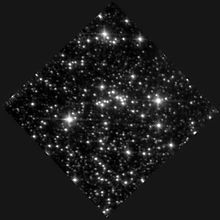1806−20 (originally named the SGR 1806−20 cluster) is a heavily obscured star cluster on the far side of the Milky Way, approximately 28,000 light-years distant.[3] Some sources claim as far as 50,000. It contains the soft gamma repeater SGR 1806−20 and the luminous blue variable hypergiant LBV 1806−20, a candidate for the most luminous star in the Milky Way. LBV 1806−20 and many of the other massive stars in the cluster are thought likely to end as supernovas in a few million years, leaving only neutron stars or black holes as remnants.
| 1806−20 cluster | |
|---|---|
| Observation data (J2000 epoch) | |
| Right ascension | 18h 08m 39.33s[1] |
| Declination | −20° 24′ 40.0″[1] |
| Distance | ~28000 ly (~8700 pc[2]) |
| Physical characteristics | |
| Contains SGR 1806−20 and LBV 1806−20. | |
| Other designations | G10.0-0.3, W31 |
| Associations | |
| Constellation | Sagittarius |

The cluster is heavily obscured by intervening dust, and mostly visible in the infrared. It is part of the larger W31 H II region and giant molecular cloud. It has a compact core of ~0.2 pc in diameter with a more extended halo of ~2 pc in diameter containing the LBV[1] and at least three Wolf–Rayet stars (of types WC8, WN6, and WN7) and an OB supergiant, plus other young massive stars.[4]
See also
editReferences
edit- ^ a b c SIMBAD/Aladin plot, of r=30 asec region around SGR B18054117-20251165
- ^ H. E. S. S. Collaboration; et al. (2018). "Extended VHE γ-ray emission towards SGR1806-20, LBV 1806-20, and stellar cluster Cl* 1806-20". Astronomy and Astrophysics. 612: 612. arXiv:1606.05404. Bibcode:2018A&A...612A..11H. doi:10.1051/0004-6361/201628695. S2CID 118345803.
- ^ Bibby, J.; Crowther, P.; Furness, J.; Clark, J. (2008). "A downward revision to the distance of the 1806-20 cluster and associated magnetar from Gemini Near-Infrared Spectroscopy". Monthly Notices of the Royal Astronomical Society. 386 (1). arXiv:0802.0815. Bibcode:2008MNRAS.386L..23B. doi:10.1111/j.1745-3933.2008.00453.x. S2CID 14466990.
- ^ Figer, Donald F.; Najarro, Francisco; Geballe, T. R.; Blum, R. D.; Kudritzki, Rolf P. (2005). "Massive Stars in the SGR 1806-20 Cluster". The Astrophysical Journal. 622 (1): L49 – L52. arXiv:astro-ph/0501560. Bibcode:2005ApJ...622L..49F. doi:10.1086/429159. S2CID 14696048.
External links
edit